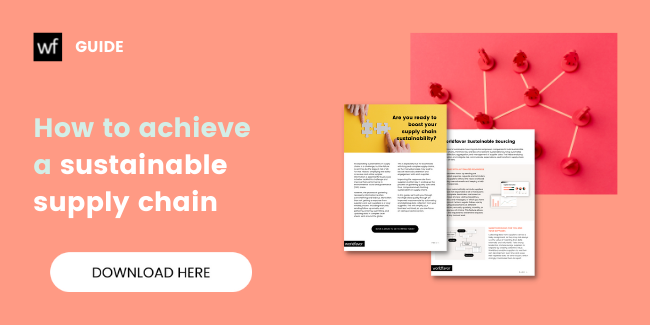6 ways companies should manage their supply chain risk in uncertain times

As businesses are recovering from two years of supply chain disruptions caused by the pandemic – another wave of chaos on supply chains has been unleashed. Just when you think it can’t get any worse – it does.
Russia’s unprovoked invasion of Ukraine combined with China’s latest zero-tolerance approach to preventing another escalating virus outbreak is causing businesses worldwide to experience further supply chain bottlenecks and increased pricing pressure. Disruption seems to be the new normal in global supply chains – so it is high time for businesses to implement a proper supply chain risk management strategy if they haven’t done so already.
If you don’t know where to start, don’t worry! In this blog, we will go through the key steps every business should take to get control over vulnerabilities and potential threats in their supply chain. Let’s have a look!
Supply chain disruption caused by the Russia-Ukraine Crisis
Russia and Ukraine are among the largest commodity-exporting nations in the world, and that the war is driving up the world’s food and energy prices worldwide is a settled fact. According to FAO, Ukraine was the fifth largest wheat exporter in 2021, and Russia was ranked as the largest exporter of nitrogen and fertilizers. Not to mention that Russia is the world’s largest oil exporter to global markets – and Europe’s economy is fueled by its natural gas.
However, the war’s impact on the global economy goes beyond the food and energy sectors. Russia is usually not seen as critical in global supply chains as other nations, such as China. However, recent analyses from both Deloitte and Dun & Bradstreet found notable linkage to suppliers in Russia and Ukraine in global supply chains – where the majority were tier-2 suppliers. According to Dun & Bradstreet, there are 7.6 million Tier 2 supplier relationships with Russian entities globally. To put it in perspective, that is more than the population of Ireland and Gambia combined (!). In addition, over 374.000 businesses worldwide rely on Russian suppliers.
Source: Deloitte – Supply chain implications of the Russia-Ukraine conflict
According to Deloitte’s Annual Global Chief Procurement Officer Survey 2021, 70% believed that they had good visibility into the risks that exist in their direct (tier 1) suppliers. Still, only 15% had visibility into lower tiers. This highlights that there is an urgent need for businesses to gain visibility into their extended supply chains and thus be able to tackle potential risks.
Best practices on how to manage your supply chain risks in times of uncertainty
While there is no one-size-fits-all approach on how businesses should manage their supply chain risks in times of crisis, there are some key steps all businesses can take to better build resilience and quicker identify vulnerabilities on all tiers of their supply chains. Let’s break them down:
1. Invest in a risk management system
When it comes to such a complex matter as risk management in a time of crisis – technology can help to create clarity and gain important insight. Implementing a supply chain risk management system is an excellent asset for companies to identify and prioritize supply chain risks quicker and more accurately. If anything, a dedicated risk management system will help you to succeed with the following key steps:
2. Perform risk assessment across all tiers to access critical supply chain data
Many companies are settling with insights and monitoring risk assessment for their direct suppliers only. But to be frank, the most severe risks are usually hidden deep down in the supply chain, and they are usually the ones companies must keep an eye on. To properly identify and even prevent risks – achieving end-to-end visibility on Tier 2, Tier 3, and beyond is a must.
3. Understand and activate alternative sources of supply
Ever since the 1990s, businesses have been pursuing strategies, such as outsourcing and offshoring to reduce costs, retain market position and gain competitive advantage. While some businesses began to reconsider their complex, global supply chains as a result of disruptions from the financial crisis in 2008, supply chain disruptions have never been as prominent as today. A cocktail of disruptions generated by the pandemic, climate-related events and the war in Ukraine have caused businesses to reconsider their supply chain structure once again. This might be the time for you to take a deep look at your supply chain strategies: are you over-relying on one risky supplier? Or are your suppliers clustered in the same area? At times of socio-political and environmental instability, the power of understanding the weaknesses of your supply chain structure and sourcing for alternative suppliers should not be left unnoticed.
4. Prepare for disruption in operations in the conflict region
No matter how well-prepared a business is, anticipating risks is hard. In fact, some risks are impossible to foresee. A crisis response, i.e addressing active risks, requires making quick decisions regarding disruptions in the conflicted region. For instance, at the beginning of Russia’s invasion of Ukraine, businesses with both direct and indirect operations decided whether or not they would withdraw, scale down or continue operating in Russia and Ukraine. The businesses that have decided to continue operations in the countries must prioritize their focus on the safety of the employees and be prepared for sudden logistics disruptions and shortages.
5. Conduct scenario planning exercises
Scenario planning exercises help companies to prepare for unpredictables as it enables them to understand better potential operational implications – both financial and non-financial – of various scenarios. This is especially true in times of uncertainty since it helps businesses to truly get familiar with the ongoing crisis, its potential risks, as well as opportunities. Having various scenarios and associated risk mitigation responses identified brings more confidence in your decision-making in these strange times.
6. Continuously monitor your supply chain
Regularly collecting necessary information from every tier of your supply chain is the only way to know what is going on. Evaluate risks regularly to reach a continuous cycle of identifying risky businesses before they become a problem. While supply chain risk assessments can be costly and administratively challenging, they’re essential for companies to view their performance accurately. We know that no company has limitless resources – that is why prioritizing risks helps you determine which suppliers pose the biggest threats, based on risks, such as their location or raw material source, and where to put your effort.
How can Worldfavor help?
Worldfavor enables you to easily collect and detailly track your multi-tier supply risks over time. Our Sustainainable Sourcing solution helps you to reach new levels of transparency by uncovering vulnerabilities and building resilience.
Sign up to Worldfavor Sustainable Sourcing solution today:
-
Capture relevant and hard-to-get data from all your suppliers
-
Let the platform automatically aggregate your suppliers’ data for you
-
Store the supplier data in one place, so information can easily be shared between colleagues
-
Break down your supply chain for a specific product or category
-
Identify environmental, social and governance (ESG) risks before they become a problem
-
Invite your suppliers to the Worldfavor network – it’s always free and easy for them to report
Related blog posts you might like:






%20as%20the%20deadline%20approaches.%20Learn%20about%20compliance%20requirements%2c%20potential%20delays%2c%20and%20key%20updates..png)

